Detection and Analysis of the Variation in the Minimum Ecological Instream Flow Requirement in the Chinese Northwestern Inland Arid Region by Using a New Remote Sensing Method
Abstract
:1. Introduction
2. Materials and Methods
2.1. Study Area
2.2. Datasets
2.3. Methods
2.3.1. Remote Sensing Hydrological Station Technology for River Discharge Calculation
2.3.2. A New Method to Calculate the MEIFR
3. Results
3.1. Variation in the River Discharge over the Past 32 Years
3.2. Increasing MEIFR of the Piedmont Rivers
3.3. MEIFR in the Oasis Area of This Basin
3.4. Variation in the MEIFR of Lake Aiding over the Past 32 Years
3.5. Temporal and Spatial Evolution of the MEIFR Balance in the Piedmont Zone
4. Discussion
4.1. Driving Factors of the Ecological Flow Changes in the Whole Piedmont Area
4.2. Explanation of the Balance and Maintenance Method
4.3. Advantages and Disadvantage of This Research
5. Conclusions
Author Contributions
Funding
Data Availability Statement
Conflicts of Interest
Abbreviations
| MEIFR | minimum ecological instream flow requirement; |
| EWD | ecological water demand; |
| UAV | unmanned aerial vehicle; |
| RSHS | remote sensing hydrological station; |
| RTK | real-time kinematic; |
| DSM | digital surface model; |
| DOM | digital orthographic model; |
| GEE | Google Earth engine; |
| NDWI | normalized difference water index; |
| SDGs | sustainable development goals. |
References
- Petts, G. Water Quality Characteristics of Regulated Rivers. Prog. Phys. Geogr. 1986, 10, 492–516. [Google Scholar] [CrossRef]
- Bovee, K. Development and Evaluation of Habitat Suitability Criteria for Use in the Instream Flow Incremental Methodology; USDI Fish and Wildlife Service: Washington, DC, USA, 1986.
- Gleick, P. Water in crisis: Paths to sustainable water use. Ecol. Appl. 1998, 8, 571–579. [Google Scholar] [CrossRef]
- Wang, X.; Zhang, Y.; Liu, C. A theoretical discussion of ecological and environmental water requirements of river course. J. Nat. Resour. 2003, 18, 240–246. [Google Scholar] [CrossRef]
- Liu, S.; Mo, X.; Xia, J.; Liu, C.; Lin, Z.; Men, B.; Ji, L. Uncertainty Analysis in Estimating the Minimum Ecological Instream Flow Requirements via Wetted Perimeter Method: Curvature Technique or Slope Technique. Acta Geogr. Sin. 2006, 61, 273–281. [Google Scholar] [CrossRef]
- Yang, Z.; Xie, X.; Wang, H.; He, H. The Protection of lake in arid region-oriented idea for water resources allocation case of Aiding Lake Watershed. Water Resour. Hydropower Eng. 2017, 48, 31–35. [Google Scholar] [CrossRef]
- Guo, W.; Hong, F.; Wang, B.; Yuan, W.; Wang, G.; Cheng, S.; Wang, H. Evolution and attribution of ecological flow in the Xiangjiang River basin since 1961. Environmental Science and Pollution Res. Int. 2023, 30, 104388–104407. [Google Scholar] [CrossRef]
- Dickson, B.; Albano, C.; McRae, B.; Anderson, J.; Theobald, D.; Zachmann, L.; Sisk, T.; Dombeck, M. Informing Strategic Efforts to Expand and Connect Protected Areas Using a Model of Ecological Flow, with Application to the Western United States. Conserv. Lett. 2017, 10, 564–571. [Google Scholar] [CrossRef]
- Arthington, A.; Naiman, R.; McClain, M.; Nilsson, C. Preserving the biodiversity and ecological services of rivers: New challenges and research opportunities. Freshw. Biol. 2010, 55, 1–16. [Google Scholar] [CrossRef]
- Tennant, D. Instream Flow Regimens for Fish, Wildlife, Recreation and Related Environmental Resources. Fisheries 1976, 1, 6–10. [Google Scholar] [CrossRef]
- Stalnaker, C.; Lamb, B.; Henriksen, J. The Instream Flow Incremental Methodology: A Primer for IFIM; Biological Report; Department of Interior National Biological Service: Denver, CO, USA, 1995; Volume 29.
- Karim, K.; Gubbels, E.; Goulter, I. Review Of Determination Of Instream Flow Requirements With Special Application To Australia1. J. Am. Water Resour. Assoc. 1995, 31, 199–209. [Google Scholar] [CrossRef]
- Roderick, M.; Sun, F.; Wang, Y.; Shen, Y. Attribution of satellite-observed vegetation trends in a hyper-arid region of the Heihe River basin, Western China. Hydrol. Earth Syst. Sci. 2014, 11, 3499–3509. [Google Scholar] [CrossRef]
- Nie, Y.; Guo, Y.; Tan, Y.; Huang, W.; Liu, X. Operation optimization of ecological water conveyance in Aksu River Basin based on ecological restoration. Arid. Land Geogr. 2022, 45, 325–332. [Google Scholar] [CrossRef]
- Liang, S.; Xu, T.; Zhang, H. Regulation model of ecological water demand based on hydrological regime analysis in sluice-controlled river. J. Environ. Prot. Ecol. 2021, 22, 2023–2032. [Google Scholar] [CrossRef]
- Aman, R.; Fang, C. System Dynamics and Scenario Simulation of Water Resources Carrying Capacity in Xinjiang. Environ. Sci. Technol. 2020, 43, 205–215. [Google Scholar] [CrossRef]
- Jiapaer, G.; Chen, X.; Bao, A.M. A comparison of methods for estimating fractional vegetation cover in arid regions. Agric. For. Meteorol. 2011, 151, 1698–1710. [Google Scholar] [CrossRef]
- Zhao, L. Prediction model of ecological environmental water demand based on big data analysis. Environ. Technol. Innov. 2020, 21, 101–196. [Google Scholar] [CrossRef]
- Yan, D.; Wang, H.; Wang, F.; Tang, Y. Frame of research work on ecological water demand and key topics. J. Hydraul. Eng. 2007, 38, 267–273. [Google Scholar] [CrossRef]
- Bishop, C.A.; Liu, J.G.; Mason, P.J. Hyperspectral remote sensing for mineral exploration in Pulang, Yunnan Province, China. Int. J. Remote Sens. 2011, 32, 2409–2426. [Google Scholar] [CrossRef]
- Garambois, P.; Monnier, J. Inferrence of effective river properties from remotely sensed observations of water surface. Adv. Water Resour. 2015, 79, 103–120. [Google Scholar] [CrossRef]
- Yang, S.; Pan, Z.; Lou, H.; Li, C.; Zhang, J.; Zhang, Y.; Yin, Y.; Gong, J.; Luo, Y.; Zhi, M.; et al. Reconstruction of the water cycle process reveals the 600-year evolution of the human-water relationship in Tunpu, China. J. Hydrol. 2023, 617, 128927. [Google Scholar] [CrossRef]
- Lou, H.; Yang, S.; Shi, X.; Zhang, J.; Pan, Z.; Li, C.; Zhang, Y.; Zhou, B.; Li, H.; Shi, Y.; et al. Whether the enhanced terrestrial vegetation carbon sink affect the water resources in the middle-low latitude karst areas of China? J. Hydrol. 2023, 620, 129510. [Google Scholar] [CrossRef]
- Lewin, J.; Gibbard, R. Quaternary river terraces in England: Forms, sediments and processes. Geomorphology 2010, 120, 293–311. [Google Scholar] [CrossRef]
- Zhang, X.; Jiao, Z.; Zhao, C.; Qu, Y.; Liu, Q.; Zhang, H.; Tong, Y.; Wang, C.; Li, S.; Guo, J.; et al. Review of Land Surface Albedo: Variance Characteristics, Climate Effect and Management Strategy. Remote Sens. 2022, 14, 1382. [Google Scholar] [CrossRef]
- Lou, H.; Zhang, Y.; Yang, S.; Wang, X.; Pan, Z.; Luo, Y. A New Method for Long-Term River Discharge Estimation of Small- and Medium-Scale Rivers by Using Multisource Remote Sensing and RSHS: Application and Validation. Remote Sens. 2022, 14, 1798. [Google Scholar] [CrossRef]
- Pan, Z.; Yang, S.; Lou, H.; Li, C.; Zhang, J.; Zhang, Y.; Luo, Y.; Li, X. Perspectives of human–water co-evolution of blue–green water resources in subtropical areas. Hydrol. Process. 2023, 37, e14818. [Google Scholar] [CrossRef]
- Lou, H.; Li, H.; Yang, S.; Wang, X.; Pan, Z.; Zhang, Y.; Zhou, B.; Zhang, J.; Zhang, X. River discharge recovery lag in the small and medium-sized rivers occurred in response to climate change and human activities. J. Hydrol. 2023, 620, 129453. [Google Scholar] [CrossRef]
- Pan, Z.; Yang, S.; Ren, X.; Lou, H.; Zhou, B.; Wang, H.; Zhang, Y.; Li, H.; Li, J.; Dai, Y. GEE can prominently reduce uncertainties from input data and parameters of the remote sensing-driven distributed hydrological model. Sci. Total Environ. 2023, 870, 161852. [Google Scholar] [CrossRef]
- Taniguchi-Quan, K.; Irving, K.; Stein, E.; Poresky, A.; Wildman, R.A., Jr.; Aprahamian, A.; Rivers, C.; Sharp, G.; Yarnell, S.; Feldman, J. Developing Ecological Flow Needs in a Highly Altered Region: Application of California Environmental Flows Framework in Southern California, USA. Front. Environ. Sci. 2022, 10, 787631. [Google Scholar] [CrossRef]
- Jiang, X.; Pi, H.; Zhou, R.; Huang, X. Study on Calculating Ecological Water Demand of Rivers Using Wetted Perimeter Method Based on Unmanned Aerial Vehicle Telemetry Technology. China Rural. Water Hydropower 2022, 486, 62–68. [Google Scholar] [CrossRef]
- Wang, Y.; Qin, D. Influence of climate change and human activity on water resources in arid region of Northwest China: An overview. Adv. Clim. Chang. Res. 2017, 8, 268–278. [Google Scholar] [CrossRef]
- Wang, Y.; Zhou, B.; Qin, D.; Wu, J.; Gao, R.; Song, L. Changes in Mean and Extreme Temperature and Precipitation over the Arid Region of Northwestern China: Observation and Projection. Adv. Atmos. Sci. 2017, 34, 289–305. [Google Scholar] [CrossRef]
- Yao, X.; Zhang, M.; Zhang, Y.; Wang, J.; Xiao, H. New insights into climate transition in northwest China. Arid. Land Geogr. 2022, 45, 671–683. [Google Scholar] [CrossRef]
- Nhassengo, O.; Somura, H.; Wolfe, J. Environmental flow sustainability in the Lower Limpopo River Basin, Mozambique. J. Hydrol.-Reg. Stud. 2021, 36, 14. [Google Scholar] [CrossRef]
- Diaz-Caravantes, R.; Zuniga-Teran, A.; Martin, F.; Bernabeu, M.; Stoker, P.; Scott, C. Urban water security: A comparative study of cities in the arid Americas. Environ. Urban. 2020, 32, 275–294. [Google Scholar] [CrossRef]
- Yarnell, S.; Willis, A.; Obester, A.; Peek, R.; Lusardi, R.; Zimmerman, J.; Grantham, T.; Stein, E. Corrigendum: Functional Flows in Groundwater-Influenced Streams: Application of the California Environmental Flows Framework to Determine Ecological Flow Needs. Front. Environ. Sci. 2022, 10, 1097–1098. [Google Scholar] [CrossRef]
- Chen, F.; Wang, Y.; Wu, Z.; Feng, P. Impacts of Climate Change and Human Activities on Runoff of Continental River in Arid Areas Taking Kensiwate Hydrological Station in Xinjiang Manas River Basin as an Example. Arid. Zone Res. 2015, 32, 692–697. [Google Scholar] [CrossRef]
- Huang, F.; Ochoa, C.; Chen, X.; Cheng, Q.; Zhang, D. An entropy-based investigation into the impact of ecological water diversion on land cover complexity of restored oasis in arid inland river basins. Ecol. Eng. 2020, 151, 2012–2024. [Google Scholar] [CrossRef]
- Ren, K.; Huang, S.; Huang, Q.; Wang, H.; Leng, G.; Cheng, L.; Fang, W.; Li, P. A nature-based reservoir optimization model for resolving the conflict in human water demand and riverine ecosystem protection. J. Clean. Prod. 2019, 231, 406–418. [Google Scholar] [CrossRef]
- Suen, J.; Eheart, J. Reservoir management to balance ecosystem and human needs: Incorporating the paradigm of the ecological flow regime. Water Resour. Res. 2006, 42, 34171–34179. [Google Scholar] [CrossRef]
- Parivar, P.; Quanrud, D.; Sotoudeh, A.; Abolhasani, M. Evaluation of urban ecological sustainability in arid lands (case study: Yazd-Iran). Environ. Dev. Sustain. 2021, 23, 2797–2826. [Google Scholar] [CrossRef]
- Miranda, R.; Hermoso, V.; Hassall, C. Ecological quality and conservation status of inland waters. Inland Waters 2019, 9, 275–277. [Google Scholar] [CrossRef]
- Cai, X.; Rosegrant, M. Optional water development strategies for the Yellow River Basin: Balancing agricultural and ecological water demands. Water Resour. Res. 2004, 40, 11. [Google Scholar] [CrossRef]
- Aman, R.; Fang, C.; Zhao, R. Research on the Water Resources Carrying Capacity and Spatial-Temporal Characteristics in Xinjiang. Resour. Environ. Yangtze Basin 2020, 29, 1576–1585. [Google Scholar] [CrossRef]
- Fang, K.; Xu, A.; He, J.; Fang, C.; Liu, Q. Integrated assessment and division management of sustainable development in the Belt and Road countries. Chin. Sci. Bull. Chin. 2021, 66, 2441–2454. [Google Scholar] [CrossRef]
- Yue, L.; Qi, S.; Li, J. Research on Ecological Restoration Technology in Arid or Semi-arid Areas from the Perspective of the Belt and Road Initiative. J. Resour. Ecol. 2022, 13, 964–976. [Google Scholar] [CrossRef]
Disclaimer/Publisher’s Note: The statements, opinions, and data contained in all publications are solely those of the individual author(s) and contributor(s), and not of MDPI and/or the editor(s). MDPI and/or the editor(s) disclaim responsibility for any injury to people or property resulting from any ideas, methods, instructions, or products referred to in the content. |

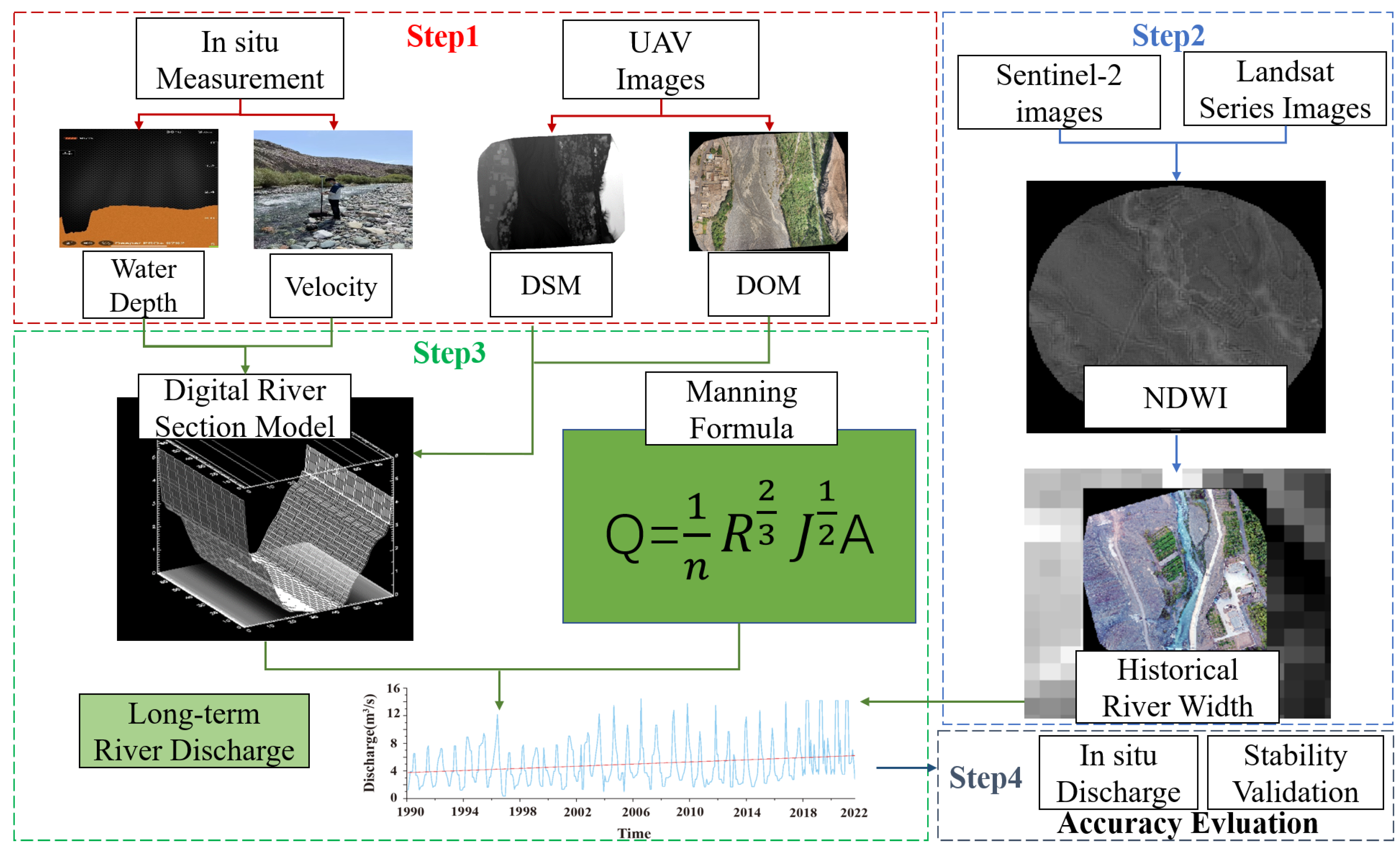
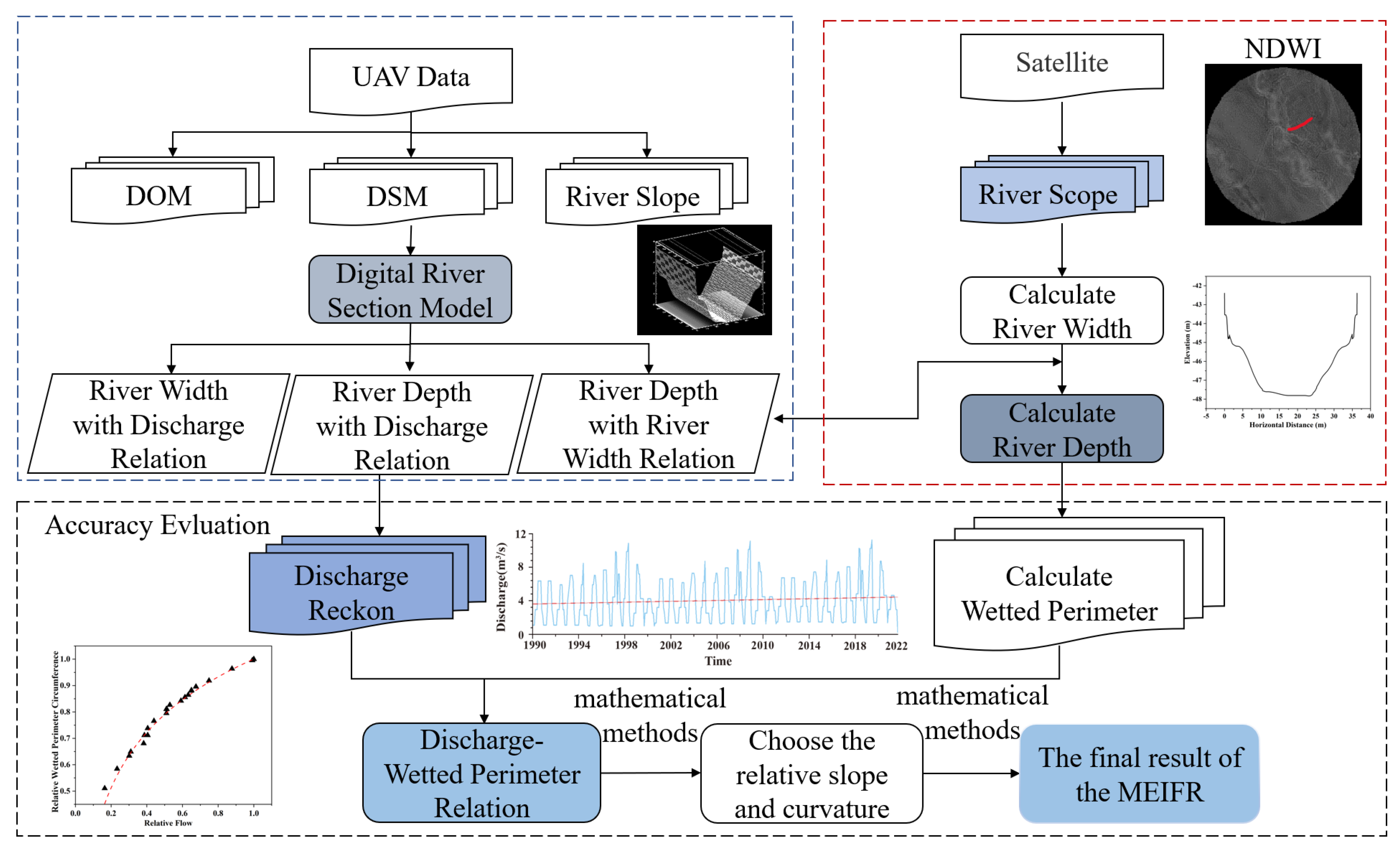

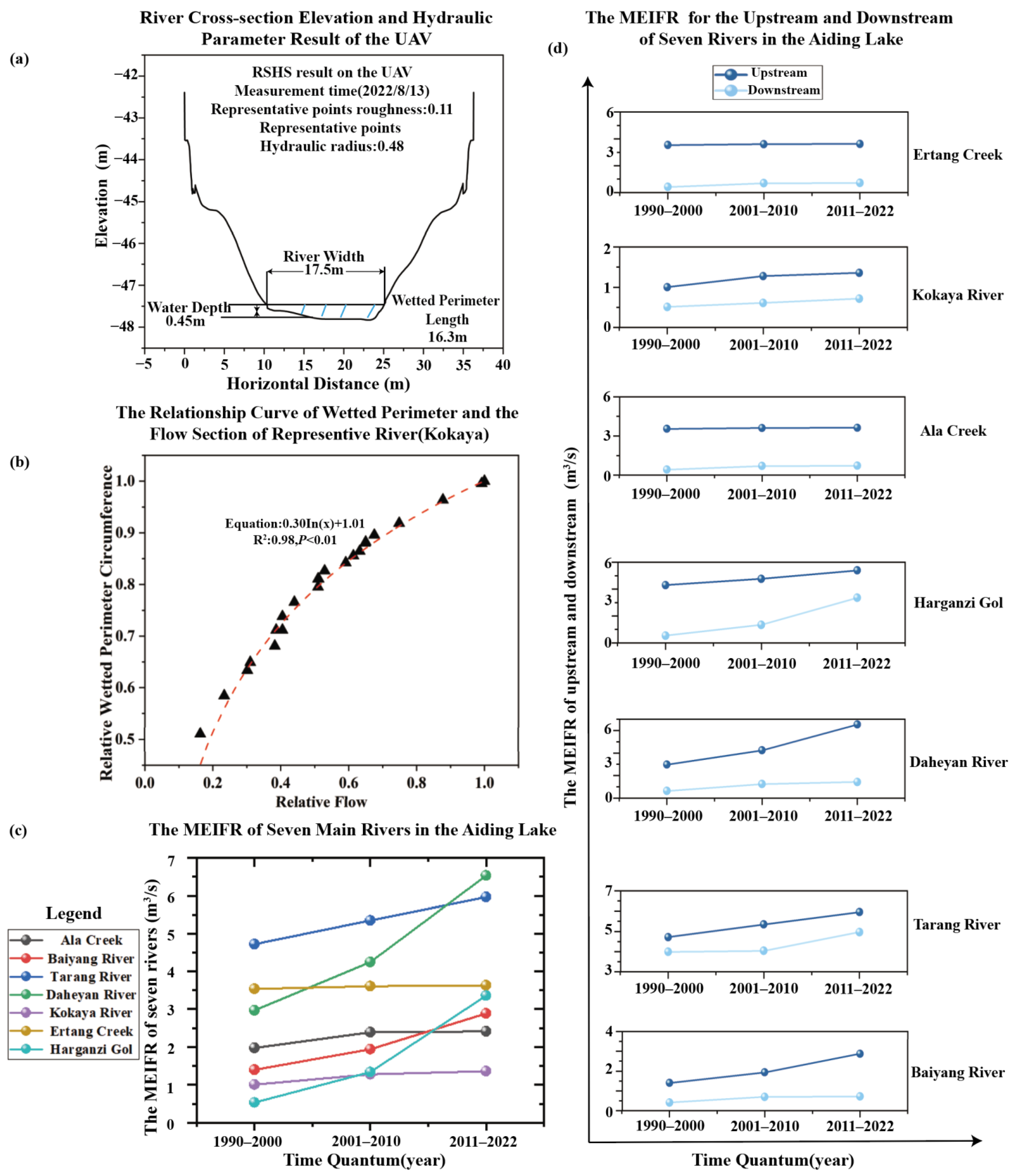

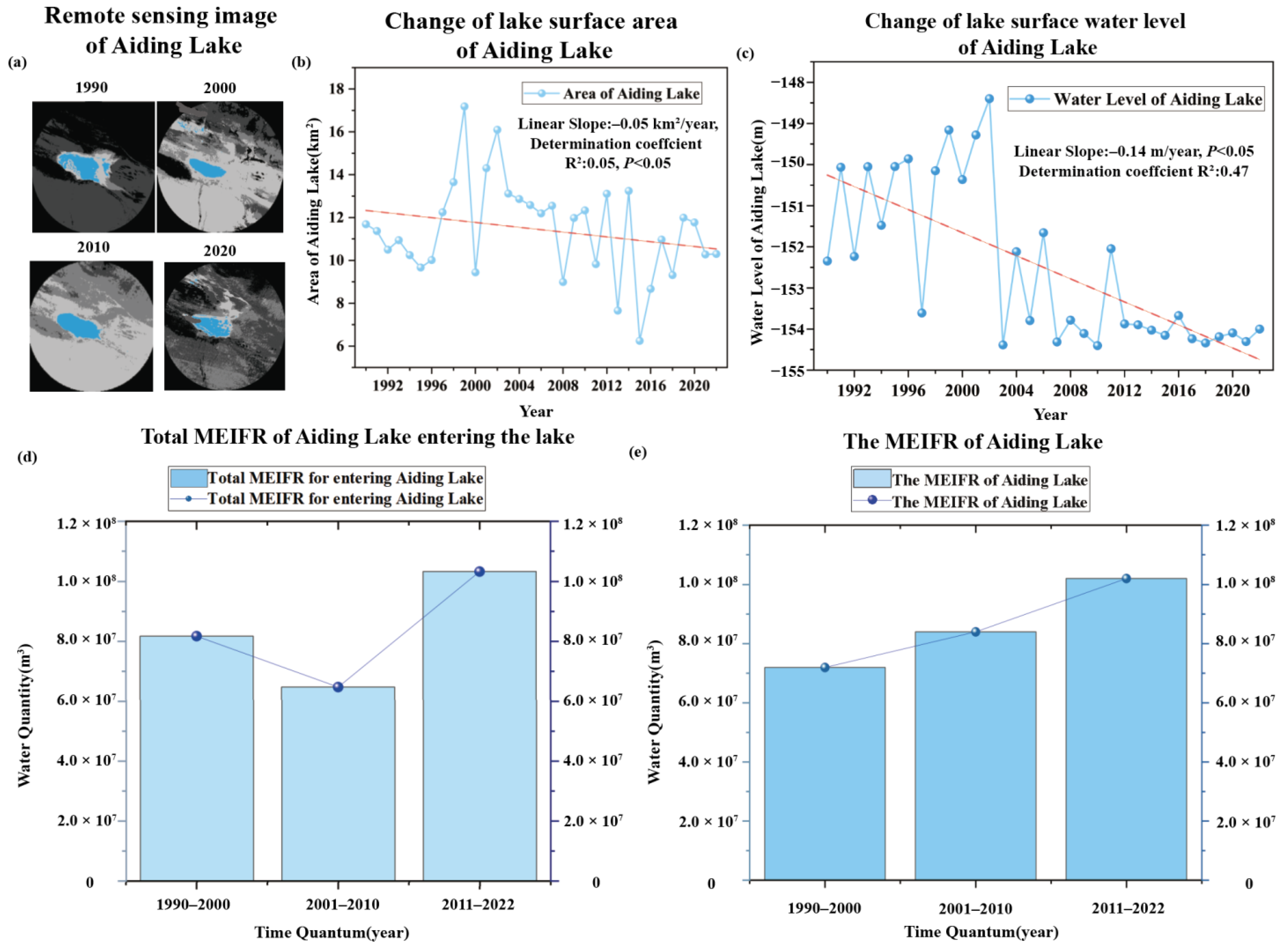
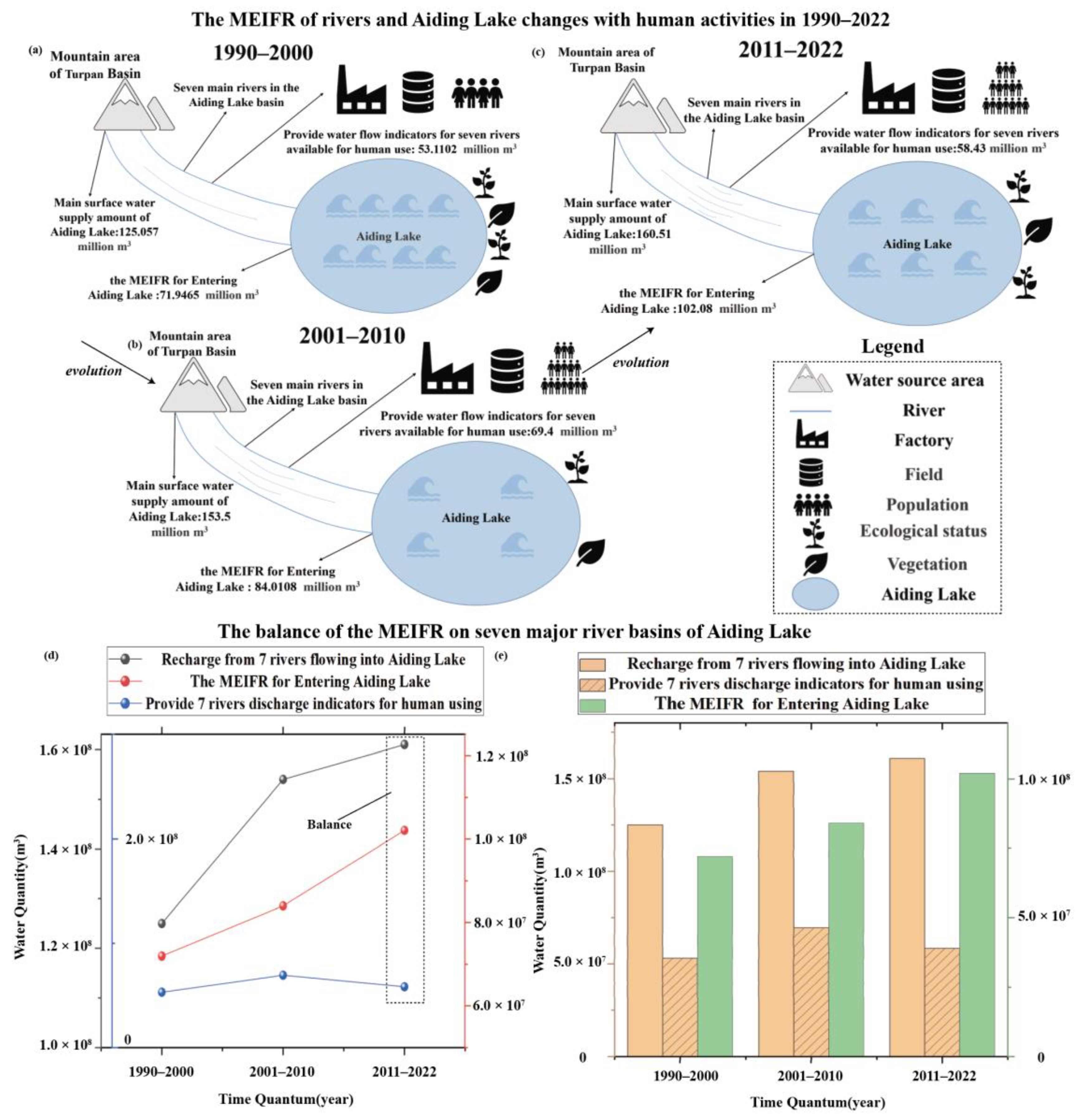
| Data Type | Data Name | Source | Date Range (Temporal Resolution) | Spatial Resolution | Purpose |
|---|---|---|---|---|---|
| Remote sensing data | UAV remote sensing | DJI Mavic Air 2 | 2022/7–2022/8 (/) | 5 cm | Construct a digital river model |
| Digital surface model | Pix4d | 2022/7–2022/8 (/) | 5 cm | ||
| Digital orthographic image | Pix4d | 2022/7–2022/8 (/) | 5 cm | ||
| Landsat-5 surface reflectance | GEE | 1990/01–2011/10 (16 days) | 30 m | Identify water body | |
| Landsat-7 surface reflectance | GEE | 2011/11–2013/03 (16 days) | 30 m | ||
| Landsat-8 surface reflectance | GEE | 2013/04–2017/03 (16 days) | 30 m | ||
| Sentinel-2 surface reflectance | GEE | 2017/03–2022/12 (10 days) | 10 m | ||
| In situ survey data | Measured velocity of flow and water depth of river section | Rotating Element Current Metre and Deeper Smart Sonar | 2022/7–2022/8 (/) | / | Establish RSHS |
| Historical statistics data | Hydrological discharge | Xinjiang Hydrological Statistical Yearbook | 2022 | / | Accuracy verification |
Disclaimer/Publisher’s Note: The statements, opinions and data contained in all publications are solely those of the individual author(s) and contributor(s) and not of MDPI and/or the editor(s). MDPI and/or the editor(s) disclaim responsibility for any injury to people or property resulting from any ideas, methods, instructions or products referred to in the content. |
© 2023 by the authors. Licensee MDPI, Basel, Switzerland. This article is an open access article distributed under the terms and conditions of the Creative Commons Attribution (CC BY) license (https://creativecommons.org/licenses/by/4.0/).
Share and Cite
Yang, S.; Li, J.; Lou, H.; Dai, Y.; Pan, Z.; Zhou, B.; Wang, H.; Li, H.; Ding, J.; Zheng, J. Detection and Analysis of the Variation in the Minimum Ecological Instream Flow Requirement in the Chinese Northwestern Inland Arid Region by Using a New Remote Sensing Method. Remote Sens. 2023, 15, 5725. https://doi.org/10.3390/rs15245725
Yang S, Li J, Lou H, Dai Y, Pan Z, Zhou B, Wang H, Li H, Ding J, Zheng J. Detection and Analysis of the Variation in the Minimum Ecological Instream Flow Requirement in the Chinese Northwestern Inland Arid Region by Using a New Remote Sensing Method. Remote Sensing. 2023; 15(24):5725. https://doi.org/10.3390/rs15245725
Chicago/Turabian StyleYang, Shengtian, Jiekang Li, Hezhen Lou, Yunmeng Dai, Zihao Pan, Baichi Zhou, Huaixing Wang, Hao Li, Jianli Ding, and Jianghua Zheng. 2023. "Detection and Analysis of the Variation in the Minimum Ecological Instream Flow Requirement in the Chinese Northwestern Inland Arid Region by Using a New Remote Sensing Method" Remote Sensing 15, no. 24: 5725. https://doi.org/10.3390/rs15245725






